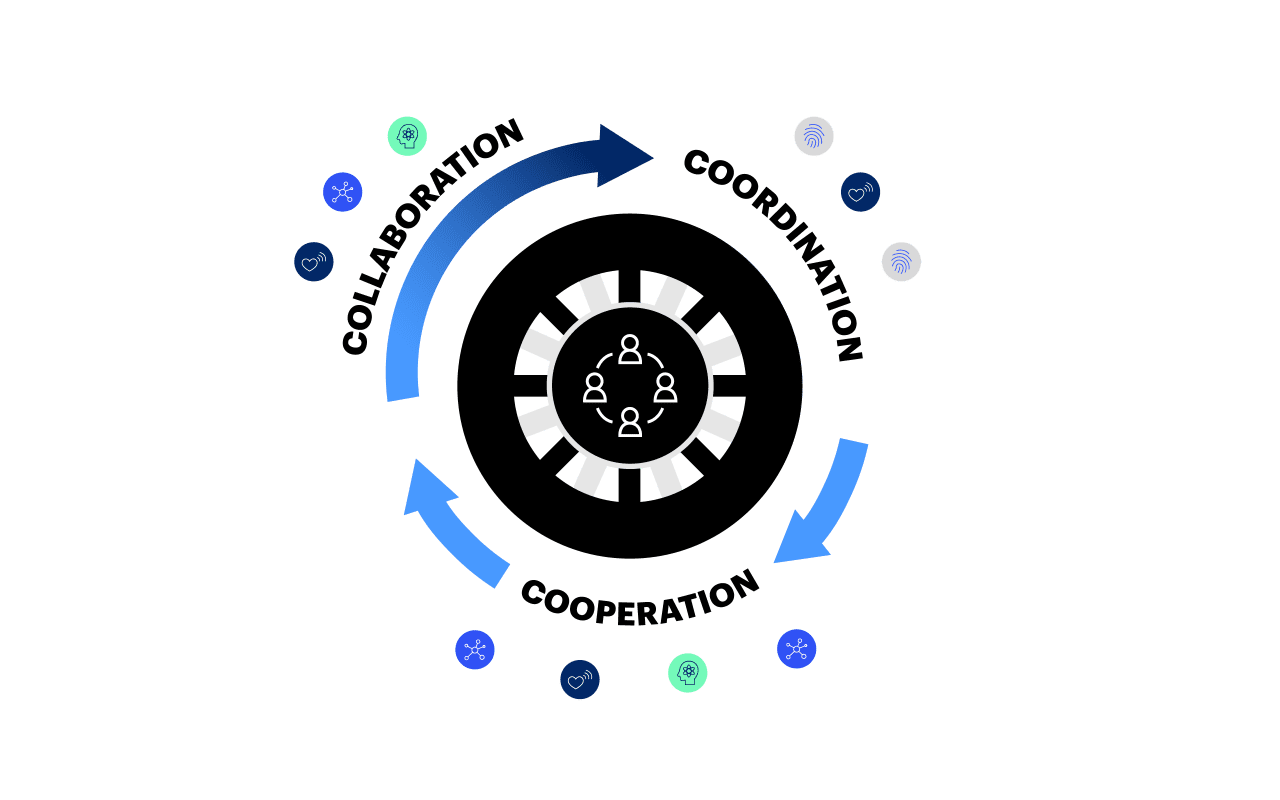BLOG
Is Ineffective Collaboration Hindering Your Organization’s Transformation?
Remote work makes cross-organizational change harder. But our Collaboration Flywheel model shows that the right interventions can create a virtuous cycle of cooperation.
As businesses work toward transformation, many find themselves trapped in a structural paradox. The Collaborative Advantage, the latest global research report from Prophet’s Organization & Culture practice, finds 80% of business leaders recognize that collaboration throughout the enterprise is essential. Yet, 50% are struggling to achieve it. And hybrid working compounds this challenge further with only 28% saying they believe their organization effectively supports collaboration in this environment.
The most successful transformers? They have worked to break down silos and build collaborative muscles by progressing through three essential phases, which we have encapsulated in a new model: Collaboration Flywheel. It’s a virtuous cycle of interdepartmental breakthroughs that reveals a path for leaders to more impactful outcomes and faster growth.
Prophet’s Collaboration Flywheel
The Flywheel provides a perfect metaphor for organizational culture. Taking a holistic, human-centered approach, it works by reinforcing positive behaviors and outcomes and minimizing negative feedback loops. It builds momentum over time. Each time the wheel turns, it generates more power and benefits for both the business and individuals.

Phase One: Coordination
This is where many organizations begin and end their development journey. Different groups, traditionally siloed, recognize the need to align horizontally rather than vertically. When leaders promote a broader strategic goal, teams understand that working together is beneficial. And they also understand when it makes more sense to continue with traditional, business-as-usual approaches. To create clarity, organizations need to define the goal and role model the desired collaborative work.
An example of this in practice might be helping employees to invest time in understanding how different parts of the organization work and identify connection points (e.g., shadow a colleague in another function) or creating a shared vocabulary – even just a few key terms – to use consistently in cross-organizational efforts.
Phase Two: Cooperation
As each group gains experience in coordination, they get a clearer understanding of how their work fits into the bigger picture. Trust, shared ways of working and incentives become more explicit, making it easier for groups to proactively call on collective capabilities. They move into the who and how of the collaborative effort. They start to define roles and decision-making responsibilities.
They see the value of shared effort more quickly. They’re informed by a common ambition, a central fact base and well-articulated ways of working. They will also have the right tools to navigate the complexity of their growing interdependence. All of this means cooperation is far more likely to have a greater collective impact than straightforward coordination might produce and depend less on the day-to-day involvement of leadership.
Phase Three: Collaboration
As this proactive cooperation builds a shared context across independent groups, interdependence and synergy increase. At this point, the organization can celebrate the visible progress of piloting and embedding new ways of working. Cross-organizational teams see an increase in quality, with a healthy mix of synchronous and asynchronous work. Synchronously working teammates often generate new ideas together. Asynchronously working colleagues bring objectivity and clarity.
Working together becomes the norm, not the exception. And so, the Flywheel spins. When combined with our human-centered approach to transformation, this new organizational muscle of collaboration taps into the enterprise’s DNA, Body, Mind and Soul.
With collaboration now a default behavior, it becomes sustainable. Innovation and disruption replace old and ineffective ways of working, which in turn leads to accelerated transformation and results for the enterprise.
Better Outcomes – For the Business and Individuals
The research shows that higher levels of teamwork enrich individuals, building new skills that increase engagement and job satisfaction – a critical lever in today’s dynamic talent landscape. Of the 1,000+ people we spoke to across the U.S., Europe and Asia, 77% say the organizational emphasis on collaboration enables higher productivity.
As evidence of its ROI increases, it’s clear that collaboration has moved from a buzzword to a core business strategy. Organizations no longer need to be sold on the benefits and importance of collaboration. Leaders and managers worldwide understand that practical cross-organizational efforts lead to greater success.
This is especially true as companies step up their efforts in diversity, equity and inclusion, and environmental, social and governance issues. By definition, this work needs to permeate every part of the company and be understood by each employee. Often, it even requires reaching out beyond the organization’s borders and interacting with external stakeholders that may include government, NGOs and communities.
FINAL THOUGHTS
Collaboration is the future of work. Securing the next competitive advantage depends on agility, finding the most effective and innovative ways to bring the best out of every part of the enterprise. And it calls for incorporating that fluidity into the organizational DNA. Working together, companies are learning, is what sets them apart.
Want to learn more about how to unleash the transformative power of collaboration? Download The Collaborative Advantage report now.
